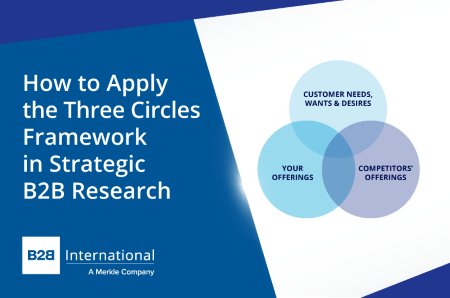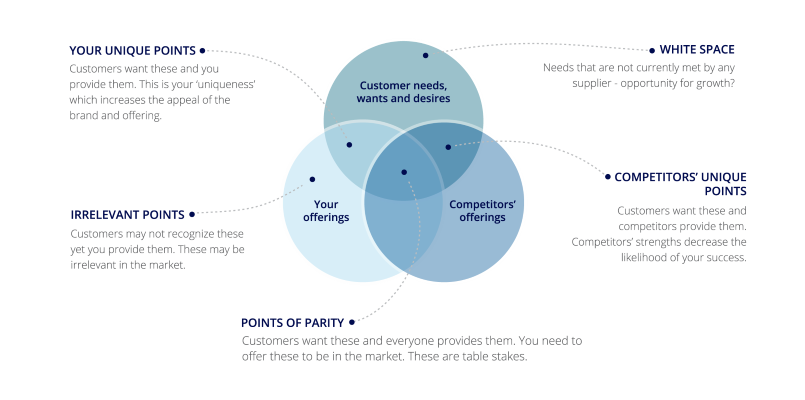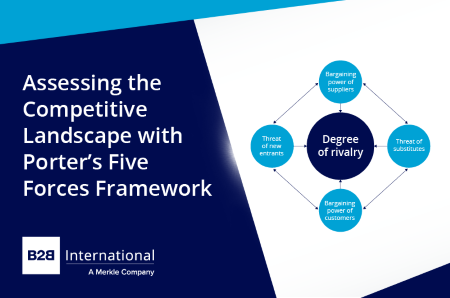
Developing a winning value proposition and brand positioning strategy are two of the biggest challenges that companies face and they can often end in failure because companies may talk about things the market doesn’t care about, they might talk about things their competitors can beat them on, or they might talk about things that simply aren’t strengths of the company.
At B2B International, we use The Three Circles Framework in our strategic B2B research studies to overcome this challenge by ensuring our clients understand customer needs and their own strengths and weaknesses relative to the competition and build their value propositions and positioning strategies accordingly.
The Three Circles Framework consists of customer needs, company strengths, and competitor strengths, and each of these areas interlink to reveal the points of parity in the market and the points of differentiation our clients or their competitor’s may have. These insights help to understand which customer needs are currently being met and by which companies and understand where a company currently sits in the market space against competitors.

The Three Circles Framework Process
-
Assess market needs – companies should not be developing value propositions or building a positioning strategy that the market doesn’t desire, care about, or resonate with. Customer needs and segmentation research is used to identify the needs, wants, and desires of the market and establish which are currently being met by the client and the wider market and where there are gaps for opportunities to grow.
-
Assess your company’s strengths – companies should also be looking inwards and focusing their value proposition and positioning efforts around maximizing their own strengths. The Three Circles Framework helps our clients to identify and understand their unique points, i.e. where they uniquely and effectively meet customer needs, and their irrelevant points, i.e. parts of their offer which may be strong but are not desired by the market.
-
Assess competitor strengths – finally, understanding the competitive landscape is crucial to developing profitable value propositions and building a differentiated positioning. The third step is therefore an analysis of competitor strengths and the extent to which they uniquely meet customer needs or provide a stronger offer compared to our client’s.
How the Three Circles Framework Helps Companies Win
-
The ‘points of parity’: If a client’s strengths equal or better the competitor’s strengths, they can choose to play in what we call the ‘brand battleground’ which is the intersection of all three circles. These ‘points of parity’ are the products, services, and capabilities that the customer wants and that everyone provides and so it can be very challenging to win in this space.
-
The ‘points of differentiation’: What is often more successful is if a client chooses to focus on their ‘points of differentiation’ which is the intersection of customer needs and their own strengths. These are the existing products, services, and capabilities that successfully meet customer needs and that no-one else provides.
-
The ‘white space’: Alternatively, a client can decide to go after the ‘white space’ by developing a set of products, services, and capabilities that answer the market’s unmet needs. If executed correctly, this strategy can help a company capture additional market share and grow quickly.
Use Cases for the Three Circles Framework in B2B Research
-
Customer needs research: The Three Circles Framework can be applied to customer needs research to help identify unique areas for differentiation by exploring what customers value and how a company can align their offerings to meet customer requirements.
-
Customer segmentation research: The Three Circles Framework can also be used to help segment the B2B market based on customer needs and perceptions by identifying key distinct customer groups with varying preferences and tailor the strategies and offering accordingly.
-
Value proposition research: As already discussed, the Three Circles Framework can be useful in providing insight for value proposition development. The three distinct areas can clearly highlight what customers value, how customers perceive a company’s offering, and how customers perceive competitor’s offering. The overlap of the different areas can provide valuable insights for crafting effective value propositions.
-
Product development research: When introducing new B2B products or services, the Three Circles Framework can be used to understand customer needs, evaluate how the product meets those needs, and compare this to competitors’ offerings. These insights help to inform product features, pricing, and positioning.
-
Competitor analysis and understanding research: Finally, the Three Circles Framework can be used for competitor analysis by assessing competitor strengths and weaknesses to understand where an organization can differentiate itself and gain a competitive advantage.
In summary, the Three Circles Framework can be incredibly beneficial to inform a customer-centric strategy, provide white space exploration, delve deeper into competitor awareness, and provide positioning insight, all by taking a holistic view of the business environment.
Readers of this article also viewed:
What to Consider When Evaluating Market Opportunities How Market Research Can Help Guide Your Market Entry Strategy Assessing Market Attractiveness with the Directional Policy Matrix Competitive Landscape Analysis with Porter’s Five Forces Framework B2B Insights Podcast #64: The Best Frameworks to Develop Winning Propositions When to Use Qualitative Research to Better Understand Your Customers and Their Needs Using the Push-Pull Model to Successfully Bring New Products to Market
To discuss how our tailored insights programs can help solve your specific business challenges, get in touch and one of the team will be happy to help.



